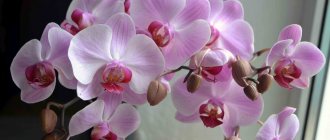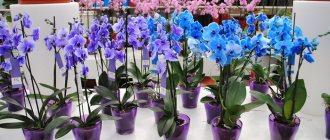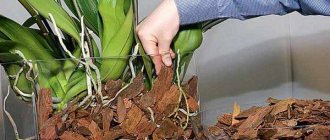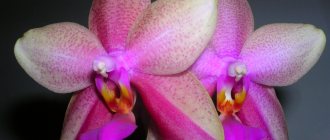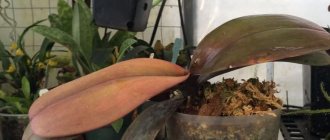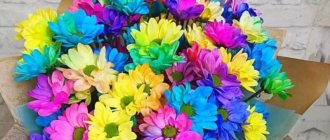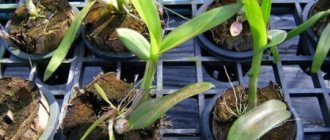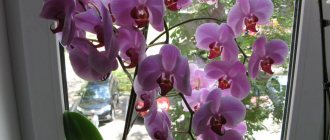Warning
: Use of undefined constant callback_thumbing_img — assumed 'callback_thumbing_img' (this will throw an Error in a future version of PHP) in
/var/www/u0885669/data/www/moiorhidei.ru/wp-content/themes/motheme/includes/ kama_thumbnail.php
on line
337
Hundreds of years of evolution and cultivation of delightful flowers, striking in their beauty and unique grace, aromas and forms, have given thousands of orchid species to flower growers around the world. The orchid family owes such diversity not only to nature, but also to man.
In the wild there are about seventy representatives, while in the decorative environment there are thousands. This suggests that orchids interbreed well and have good survival rate. Thanks to hybridization, true flower connoisseurs have the opportunity to see all possible types of orchids in their greenhouses, gardens, and home collections.
This article will talk about the species of the orchid family, their classification, and will also consider some of them separately. Also, the answer to the question will be given: how many types of orchids are there? Varietal orchids and the most memorable species of each orchid variety will be presented.
Important! It is not so easy to determine the variety of orchid at home, since today there are a great many hybrids. But it is worth noting that there are still some distinctive features for each subspecies.
Photo gallery of various orchids.
Useful tips
In order for the purchased orchids to delight you with their blooms, you need to know and follow a few simple tips. For example, you need to purchase such rare flowers at special exhibitions or in stores. You should not buy an orchid with blue flowers without experience in growing phalaenopsis, as it will soon get sick and may even die.
Always remember that a painted plant requires more careful and thorough care. Therefore, it is recommended to think about whether it is worth buying a blue orchid. No need to paint it blue yourself. If you follow all these recommendations, then an indoor orchid garden will delight any amateur gardener with its varied blooms.
Yellow color of orchids
It is associated with success, wealth, luxury, being a symbol of effective energy, the eternal movement of life, and inspired impulse. It is customary to give such flowers to girls with a creative nature, distinguished by courage and ready for new beginnings. On the one hand, yellow orchids hint at friendship and respect, and on the other hand, they can indicate a desire for a long-term, serious romance. In this case, to avoid ambiguity, it is worth accompanying the gift with a note clarifying the donor’s intentions.
Pests and diseases
- Spider mites are the most common “pest” for burgundy orchids; they multiply very quickly and practically eat the plant. For any ticks and other pests, flower growers recommend immediately spraying the orchids with a special solution or soaking the roots in an insecticide for 15 minutes and quarantining them (at least for a month).
- Various rots, especially in summer, affect the roots and leaves of a weakened orchid; the flower can rot and die. If you see rotting of the root, you immediately need to save the flower: replant it, carefully cut out all the rotten roots with a knife. “Wounds” should be disinfected, sprinkled with cinnamon and lubricated with oil.
- Fungus in the bark, on the leaves.
An urgent transplant is needed here. The contaminated substrate must be changed. The pot must be disinfected, as well as the windowsill or place where the pots are placed. Use spraying with a solution of phytosporin or any other antifungal drug. Dosage preparations should be very modest, since the medicine, if it is erroneous, negatively affects the root system as a whole. To disinfect the roots, they can be treated with 3% hydrogen peroxide. - Yellowing of leaves - the orchid has “overheated” in the sun. Move it to darker places. Falling buds and leaves - not enough light. If it is autumn or winter, use additional lamps and increase daylight hours.
Attention! Beware of drafts. Do not place pots over heating radiators.
Diversity of orchids in nature
Orchids differ significantly in the location of fixation of the root system. The following types are found:
-Saprophytes
-Epiphytes
-Terrestrial species
-Lithophytes
-Xylophytes
Saprophytes
The most unusual and unusual type of orchid. They grow underground. They don't have leaves. Powerful root without branches. The stem ends with flowers. The root system can parasitize neighboring plants. A typical representative is the true nesting bird.
Epiphytes
Most orchids belong to this species.
Epiphytic orchids do not parasitize trees; they use trees only to locate and anchor their extensive root system around the tree trunk. Epiphytic roots absorb water from the external environment.
In the favorite habitats of orchids, tropical rainforests, high humidity is constantly maintained. The dry season is favorable for flowering. Nutrients are produced by photosynthesis in plant leaves. The rich variety of colors and shapes of flowers attracts pollinating insects and promotes propagation by seeds.
Many orchids do not have nectar, and insects fly in “in vain,” nevertheless pollinating the flowers. The most famous types of epiphytes are phalaenopsis and vanda.
Terrestrial species
The roots of such orchids are deepened into loose soil, where the earth is mixed with air, moss, and dry leaves. Over time, the root system produces new shoots, which makes the plant look like a bush. Miltonia and Cymbidium are typical representatives of terrestrial orchid species.
Lithophytes
These orchids grow on rocks of different sizes in the mountains. The group is poorly adapted to unfavorable conditions, especially excess humidity. Paphiopedilum, dendrobium, phalaenopsis are representatives of this group.
Xylophytes
A variety of lithophytes. They grow on limestone slopes. Representatives of xylophytes are dendrobium, phalaenopsis, and paphiopedilum.
Important! Some orchids, for example, phalaenopsis, can belong to several species at once according to their location. It can grow on trees, stones and limestone.
External characteristics
The height of an adult specimen is a distinctive characteristic of the Midi type. These plants do not grow higher than 50 cm - this indicator takes into account the size of the peduncle during the period of active flowering.
Since Midi orchids are monopodial flowers, all the leaves are collected in a basal rosette and the adult plant numbers 4-6 pieces. Over the course of a year, Midi produces an increase of 1-2 leaves from the upper growth point, and the lower leaves gradually die off.
With the beginning of the flowering period, erect peduncles are formed from the leaf axils - depending on the variety, their number varies from 1 to 5 pieces. The maximum height of Midi peduncles is 30 cm and is a characteristic of the type.
The flower shape, like that of all phalaenopsis, resembles a moth or butterfly. Two large side petals - petalia, one modified lower one - lip (labellum), and three identical sepals - sepals in various variations give rise to magnificent flowers. The maximum diameter reaches 6 cm.
The meaning of orchids at home. Orchid according to feng shui
As mentioned above, Chinese culture has its own approach to orchids. The power of the flower can be controlled.
For example, if you place a pot with a blooming orchid in your office, your financial wealth will soon increase. And an orchid in the living room will create family harmony.
Photo 2. Orchid in the living room
Staining methods
Patented coloring
The method of the Dutch nursery is patented. They explain:
- A certain environment is created (temperature, dyes) with natural elements;
- White phalaenopsis are used. They are placed in this environment. The creators claim that it is safe for orchids;
- Flowers are not only colored blue;
- The price for them is respectable. 2-3 times higher than others.
How it was bred by the Americans is unknown to us. Japanese copies are not yet offered. Or maybe we don’t know yet. And our businessmen sell them.
White phalaenopsis are used for coloring.
Injections into the peduncle
- Not everyone can afford to purchase patented blue orchids. ;
- And if they ask for exactly this, then it can be created on the spot. And on the Internet they will tell you what and how to paint;
- One of these methods is injection into the peduncle. In its lower part. It is not so dangerous for the entire plant. If it fades, other flower stalks will have lighter flowers.
By the way! Many people take this calmly. I remember one phrase: “We do this all the time in our garden store. So I have a good experience. People thank you for your advice and tips.”
Injections into the root
You can also see the results of injections into the root of the plant. This is definitely a one-time gift. But who would like such blueness? And it is already more difficult to save such a plant.
What are the dangers of painting yourself?
The introduction of various dyes greatly weakens the plants. After all, there are also advisers who advise adding dyes when watering. And they recommend special paints for flowers or food coloring. And they can help you purchase them.
I don’t really understand such flower growers. For what? Money - I'll believe it. But not the love of flowers.
Ordinary ink is also used as dyes. And there are also solvents.
The buds may wilt and fall off.
Attention! Eventually the plants may die. And even rescue efforts may not yield a positive result.
What colors are there?
At home
Not all types of orchids existing in the world will take root in the house. Hybrid species feel best in the vicinity of humans.
Orchids suitable for cultivation in an apartment without creating special greenhouse conditions are divided into two groups according to growth forms:
- Monopodial. They have only one growth point. They are characterized by apical flowering. Growth is predominantly stem. That is, the height of the orchid increases, but leaf shoots do not grow. The leaves of monopodial orchids are dense, they create a reserve of moisture, they are usually green, but they can also be variegated. Flowers can be any shade ranging from white to pink, as well as light green, orange, lilac, yellow, and in recent years, black and blue.
- Sympodal. This type of home orchid has several growth points and flowering along the entire stem. This species usually does not stretch upward, but horizontally, for example, like a loach or grapevines. The leaves are narrow and thin and die quickly. Flowers can be yellow, purple, pink, have shades intermediate between these three colors, or mixed with white, and also have double colors, spotted and gradient.
In nature
The diversity of orchids in nature includes species that live underground (saprophytes), on trees (epiphytes) and in the soil, the latter usually having a bulbous root and capable of growing in temperate latitudes.
These plants can have any natural color, but they are not found in the wild:
- Blue and light blue orchids.
- Absolutely purple, flowers with this color have yellow, white or orange inclusions.
- Black, there is controversy about this, since there is a legendary version of the appearance of black orchids, according to which it was stolen by a botanist researcher from the mysterious tribes of South America who worshiped it. The legend has no evidence. There are also some endemic species whose color is considered black.
Artificially bred plants
In terms of breeding orchids, breeders act more intuitively than clearly and thoughtfully. But even those types of colors that were obtained by trial and error evoke enthusiastic exclamations.
Among them are orchids:
- blue;
- purple;
- spotted harlequin color;
- "tiger" color;
- pure white, without a single tint or inclusions;
- mother-of-pearl.
More than half of the current “running” colors of orchids are bred, which in no way detracts from their beauty.
Five of the most beautiful orchids
In Russia, indoor flower lovers most often grow the Phalaenopsis orchid, which is also called the Fluttering Butterfly. This variety has earned its popularity due to the fact that it can bloom almost all year round. Most varieties of this orchid are currently bred in Russia. That’s why Phalaenopsis usually takes root well in the homes of indoor plant lovers.
In addition to ordinary Phalaenopsis, a miniature variety of this orchid is also very popular among indoor plant lovers. Phalaenopsis mini also blooms for a very long time and looks impressive.
Cymbidium orchids are popular in Russia, as well as throughout the world, thanks to their beautiful flowers that do not cause allergies. Cymbidium blooms more spectacularly than many other types of orchids. In addition, this variety has very beautiful dark green large leaves.
Recently, royal orchids imported from Thailand, otherwise called Vanda orchids, have also become popular among gardeners in our country. The peculiarity of this variety is that it does not need any substrate or soil at all. These orchids are most often sold in empty, beautiful glass glasses and are considered a status gift.
Another interesting orchid variety is the lady's slipper or Paphiopedilum. It is popular among indoor plant lovers because of the original shape of the flowers.
Types of orchids, their names and photos
In this section you will learn what types of indoor flowers there are, their descriptions, pictures of plants of the orchid family.
With bulbs
The bulb, or more precisely the pseudobulb (tuber, tuberidium) is a storage of nutrients. The thickening at the bottom of the stem, the “outer bulb.”
Plants with pseudobulbs belong to the sympodial type of development.
What types of orchids with pseudobulbs are there:
- lelia;
- oncidium;
- miltonia;
- odontoglossum;
- Cattleya;
- dendrobium;
- carrot orchid.
You can read more about the Lelia orchid here.
Unpretentious
Indoor phalaenopsis hybrids grow and bloom well in living rooms and are well suited for beginning gardeners. Most other species and varieties require a more individual approach.
Dendrobium, Cattleya, oncidium, Vanda are also quite easy to grow, observing the conditions: during the day it is 7 degrees warmer than at night, do not overwater in winter.
Cattleya (photo of flowers in pots).
Sympodial
Sympodial species grow in bushes, with several shoots from one rhizome:
- Cattleya;
- Cambria;
- oncidium;
- Cymbidium.
The main root is located horizontally inside the soil; new shoots with pseudobulbs easily grow from it.
Orchids are divided into monopodial and sympodial types.
Smelling
The aroma of orchids varies from completely absent to a strong, pleasant fragrance. Vanilla type flower is also used in the food industry.
The most odorous types:
- vanilla;
- lelia;
- miltonia;
- celogina;
- Cattleya;
- dendrobiums;
- phalaenopsis (many varieties);
- cymbidiums;
- Cambria;
- zygopetalum;
- miltoniopsis;
- oncidium.
Rare
The orchid family is so vast and unusual; there is a considerable list of rare species. Here are the most beautiful and rarest of them:
Royal blue phalaenopsis. Botanists from the Japanese university Chiba University created the Royal Blue variety based on the phalaenopsis Aphrodite, placing the blue gene in it. So far this miracle is not available to ordinary amateur flower growers. The basis of the unique new species is also rare - the phalaenopsis Aphrodite orchid is very difficult to propagate by seeds, so it is not grown on an industrial scale;
Royal blue phalaenopsis.
- white heron orchid, habenaria or leopard radiata;
- Flying Duck Orchid (Caleana Major);
- Odontoglossum.
Indoor
Varieties of indoor orchids include many varieties, since with skillful care even the most exotic plant will feel good, but with an inexperienced and inattentive gardener, even a stable hybrid phalaenopsis can quickly die.
Types of indoor orchids:
- phalaenopsis and its varieties;
- dendrobium;
- Wanda;
- brassia;
- miltonia;
- lelia;
- zygopetalum;
- celogina;
- cymbidium;
- oncidium;
- odontoglossum and many other species.
Find out more about what indoor orchids are and a description of these plants in our article below.
New
Based on natural species, every year new orchid hybrids are created for indoor cultivation with an extended flowering period and a reduced dormant period, of all kinds of shapes and colors.
New varieties are grouped according to the place of creation; for example, Taiwanese hybrids are distinguished.
By mixing the characteristics of different species, we obtained novelty phalaenopsis, on which new buds grow from the apical bud right during flowering. You can see a picture of the novelty variety below.
A variety of Phalaenopsis novelty flower.
Who do they give orchids to?
An orchid can be more eloquent than any speech, and it can be given to everyone. The main thing is to do it right:
- Blue ones are suitable as a gift for a lover or mother. So you will tell about its uniqueness and originality, because this is a rare type of orchid.
- Red - to the beloved woman.
- Pink ones can be presented not only to a friend, but to any beautiful lady for a holiday or wedding.
- White ones are given to mothers for the birth of a child or to creative individuals in a state of melancholy and blues.
- Purple ones are not given to young girls. This is a gift for a person who is respected.
- Yellow is given to colleagues or friends who lack inspiration and a positive attitude.
- Orange is given to a person who lacks enthusiasm, pride and courage. You can give an orange flower for any positive event.
- You can give a green one to those whom you wish good luck and happiness.
- Colorful and interspersed are given to people with whom they want a serious relationship.
Bouquets for men
A bouquet with orchids is not the most “masculine” option, but you can come up with something interesting. A men's bouquet can combine alstroemeria and orchids. Phalaenopsis variety is suitable for men. You can give your loved one an agnosia orchid.
Bouquets for women
An orchid as a gift to a woman will allow her to express all her deep feelings while remaining restrained. When choosing a freesia bouquet, look for an orchid with long stems. Orchid and roses are a great bouquet for the one you think is the only one. Orchid and feces are a gift for an unconventional and extraordinary woman. Peony and orchid - a bouquet for the queen.
Landing rules
Priming
In nature, the flower grows on trees, attached to the bark. The substrate for a home beauty should be similar to natural conditions.
The mixture includes: pieces of bark, coarse sand, humus, lowland peat, perlite, charcoal, drainage made of expanded clay or pebbles at the bottom (up to a third of the height of the container).
Sphagnum moss is laid on the surface.
Optimal capacity
Clay pots work well for the development of red orchids. Transparent containers allow you to better control the condition of the plant.
Deadlines
The need to move a flower to new soil occurs no more than once every two years. The roots sticking out of the pot signal that it has become cramped. The correct time for this procedure is after flowering has ended.
Orchids are replanted every two years.
Diseases, pests and their treatment
When keeping and breeding orchids, one should not forget about pests and plant diseases. Such as:
- rot (black, brown, gray, fusarium);
- defeat by powdery mildew;
- anthricosis;
- spider mite;
- scale insects, thrips.
The plant is affected by fungi, bacteria, and parasites. If a plant has a viral infection, it should be eliminated, since it is not possible to cure it.
Scale insects, aphids, mites and other parasites require careful treatment of the plant with preparations - phytoverm, and replacement of the substrate.
To destroy the scale insects, water procedures are carried out on the plant, the parasite is removed from all parts of the orchid, and treated with Aktelik and Fitoverm. Treatment is carried out once a week.
If root rot is detected, the substrate should be replaced immediately. The container should be washed and dried, the root system should be cleared of rotten fragments, and rinsed with a solution of foundationazole or topsin 0.2 percent. After 10 days, repeat the treatment. It is necessary to plant in a clean, disinfected substrate. For prevention, it is necessary to ensure good air supply to the roots and maintain optimal substrate humidity.
When affected by furasiose rot, use foundationazole. Treat 2-3 times a day for two weeks with a 0.2 percent solution.
Fungal diseases (anthracnose, powdery mildew, etc.) pose a danger to orchids. Fungicidal substances are used against the development of fungi. Fundazol, Topsin-M, Skor suppress fungal diseases of plants.
Gray tones
| Smoky white | WhiteSmoke | #f5f5f5 | rgb(245,245,245) |
| Gainsborough | Gainsboro | #dcdcdc | rgb(220,220,220) |
| Light gray | LightGrey,LightGray | #d3d3d3 | rgb(211,211,211) |
| Silver | Silver | #c0c0c0 | rgb(192,192,192) |
| Dark grey | DarkGray,DarkGrey | #a9a9a9 | rgb(169,169,169) |
| Grey | Gray,Grey | #808080 | rgb(128,128,128) |
| Dull gray | DimGray,DimGray | #696969 | rgb(105,105,105) |
| Light slate gray | LightSlateGray,LightSlateGrey | #778899 | rgb(119,136,153) |
| Gray slate | SlateGray,SlateGrey | #708090 | rgb(112,128,144) |
| Slate gray | DarkSlateGray,DarkSlateGrey | #2f4f4f | rgb(47,79,79) |
| Black | Black | #000000 | rgb(0,0,0) |
3
Myths about black varieties of orchids
The most common myth about the appearance of the black orchid is associated with the name of a botanist who is believed to have stolen this flower from a South American aboriginal tribe, where it was considered a totem plant.
For this act, the scientist was subjected to severe torture, however, thanks to his suffering, the world became aware of the existence of this wonderful flower.
A more romantic story of the appearance of the black orchid is associated with the story of unhappy love. However, skeptics have a different opinion: they confidently claim that the black orchid was bred artificially by Californian scientists.
Features of care
The condition of the plant is primarily affected by the correct relationship between watering and lighting.
For full natural light, windows facing west are suitable. This accommodation option is perfect both in summer and winter.
The south side is also perfect for winter, but the north and east windows are a bad option. For a painted orchid, you should provide as much natural light as possible.
The frequency of watering a flower directly depends on the lighting. The brighter the light, the more water the flower needs. Experts recommend watering a colored orchid once a week with sufficient light.
In sunny weather, the flower will need watering more than ever; in cloudy weather, the orchid will stop absorbing moisture. To determine the dryness of the soil, use a regular wooden stick. The water pressure should be weak and diffuse.
IMPORTANT! If after staining the root system remains healthy, then further care is no different from before. If the buds have fallen off, remove the damaged arrow. The plant cannot be replanted after painting; another stress for the orchid can be disastrous
Apart from replanting, there are no other restrictions; care requirements must be observed exactly the same as for a regular, healthy flower. However, you need to closely monitor the condition of your pet and quickly respond to any changes.
You cannot replant the plant after painting; another stress for the orchid can be disastrous. Apart from replanting, there are no other restrictions; care requirements must be observed exactly the same as for a regular, healthy flower. However, you need to closely monitor the condition of your pet and quickly respond to any changes.
If the buds fall off after purchase, the plant did not survive the resulting stress. In this case, measures should be taken to quickly resuscitate the flower.
If, after painting, the orchid’s buds fall off, it must be urgently revived.
Growing area
Orchids are divided into groups, taking into account the climatic zones in which they grow.
South Africa and Central America
And other areas located near the equator. Here, heat and humidity prevail, and this is exactly what orchids need - a temperature of 28 C° and a humidity of at least 60%. The root system of flowers is located on the surface and does not dry out, since the plant absorbs moisture from the air.
Tropical climate conditions are ideal for the Dendrobium orchid. The shoots of such plants can be erect or spread along the ground. The leaves are not grouped at the growing point of the flower, but are scattered along the stem. A blooming Dendrobium produces 5-8 flowers. Representatives of this species amaze with their variety of shades.
Mountains of Brazil and Andes, southeast Asia
And also Indonesia, New Guinea, Malaysia. Low temperatures prevail here compared to the tropics. But mysterious orchids managed to take root here too. Thanks to suitable temperatures and light, most of these plants grow here. The cliffs and forests are not as hot as in the tropics, but the humidity is also high, so almost all species live here. It is in these conditions that the Phalaenopsis orchid grows, a species domesticated by humans. Today, these domestic exotics decorate window sills in people's houses and apartments.
The Cattleya orchid has adapted best to life in low-temperature countries. The plant can grow up to 1.5 m in height, and during the flowering period produce up to 20 flowers on one branch. In addition, with the tacit consent of nature, this species managed to acquire a pseudobulb, which is atypical for its relatives. This new organ is a kind of exotic growth point and can retain nutrients.
Plateaus and steppes
Here the climate is not as favorable as at the equator. Native orchids have had to adapt to growing in soil. Day and night temperatures in the steppes vary greatly, so the local orchids have changed. It is in these zones that many terrestrial orchid species and a few epiphytic ones grow.
The orchid Orchis grows in the soils of steppes and plains. The leaves of this plant are decorated with gray-brown spots, which is why they are called Spotted Orchis. They reach a height of 20-60 cm. Orchis blooms profusely, decorating itself with lilac flowers.
Temperate zones
Orchids are practically not found here - temperature conditions do not allow them to successfully develop aerial roots. The flowers here grow exclusively in the ground, and even then in very small quantities.
Thailand is a kind of orchid reserve. Without exaggeration, we can say that these flowers grow literally everywhere here. It is for this reason that the country is called the record holder for the number of orchids per square meter.
